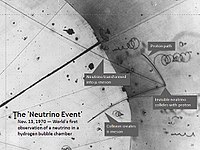
Photo from wikipedia
The KATRIN experiment aims to measure the effective mass of the electron antineutrino from the analysis of electron spectra stemming from the beta-decay of molecular tritium with a sensitivity of… Click to show full abstract
The KATRIN experiment aims to measure the effective mass of the electron antineutrino from the analysis of electron spectra stemming from the beta-decay of molecular tritium with a sensitivity of 200 meV. Therefore, a daily throughput of about 40 g of gaseous tritium is circulated in a windowless source section. An accurate description of the gas flow through this section is of fundamental importance for the neutrino mass measurement as it significantly influences the generation and transport of beta-decay electrons through the experimental setup. In this paper we present a comprehensive model consisting of calculations of rarefied gas flow through the different components of the source section ranging from viscous to free molecular flow. By connecting these simulations with a number of experimentally determined operational parameters the gas model can be refreshed regularly according to the measured operating conditions. In this work, measurement and modelling uncertainties are quantified with regard to their implications for the neutrino mass measurement. We find that the systematic uncertainties related to the description of gas flow are represented by $\Delta m_{\nu}^2=(-3.06\pm 0.24)\cdot10^{-3}$ eV$^2$, and that the gas model is ready to be used in the analysis of upcoming KATRIN data.
Journal Title: Vacuum
Year Published: 2018
Link to full text (if available)
Share on Social Media: Sign Up to like & get
recommendations!